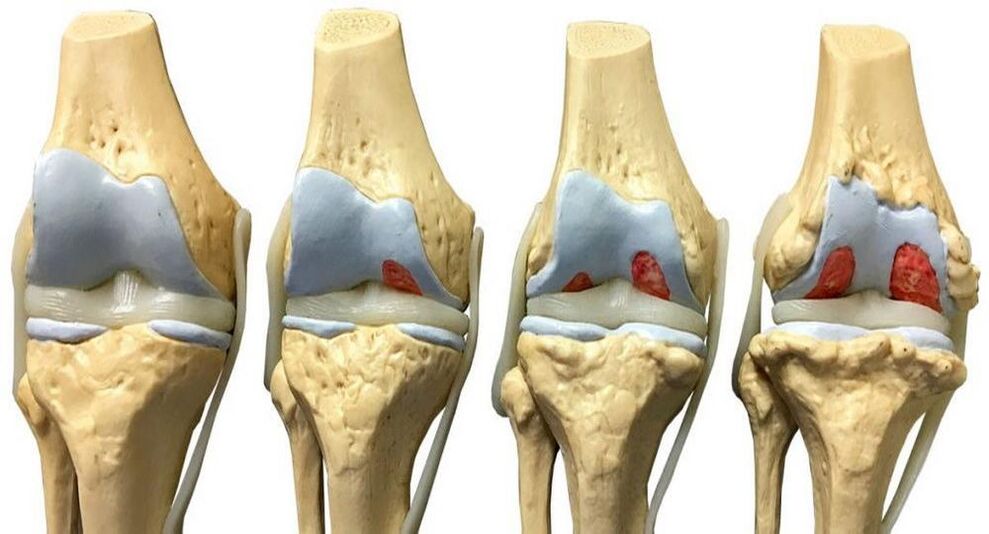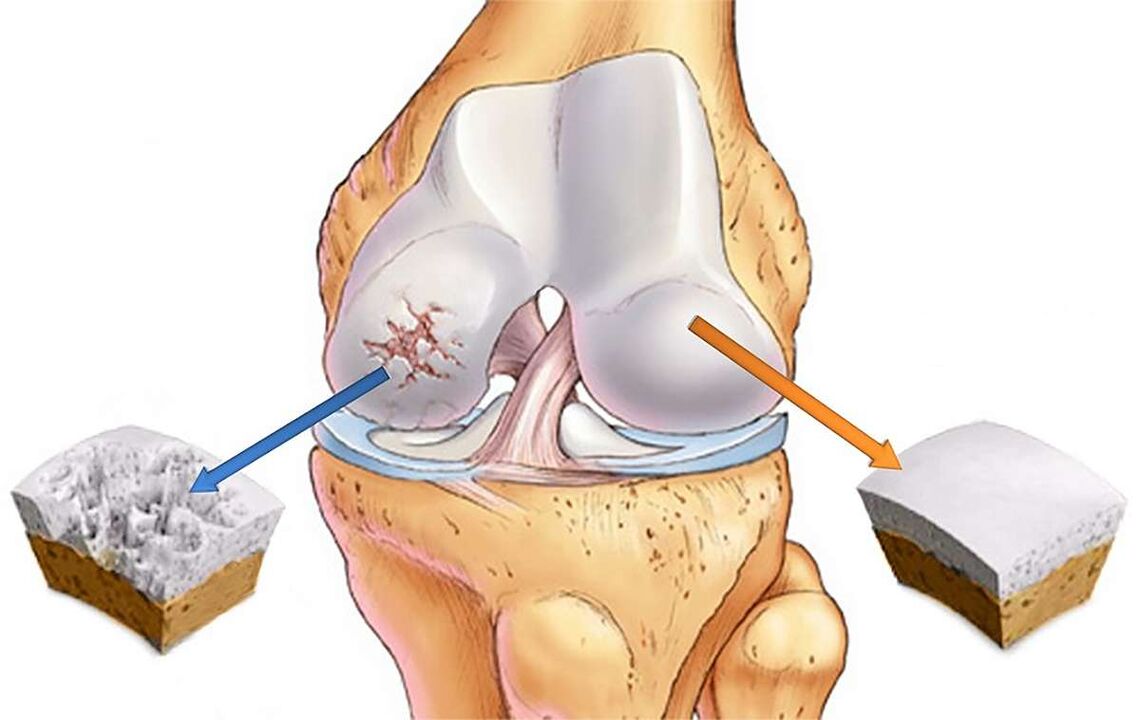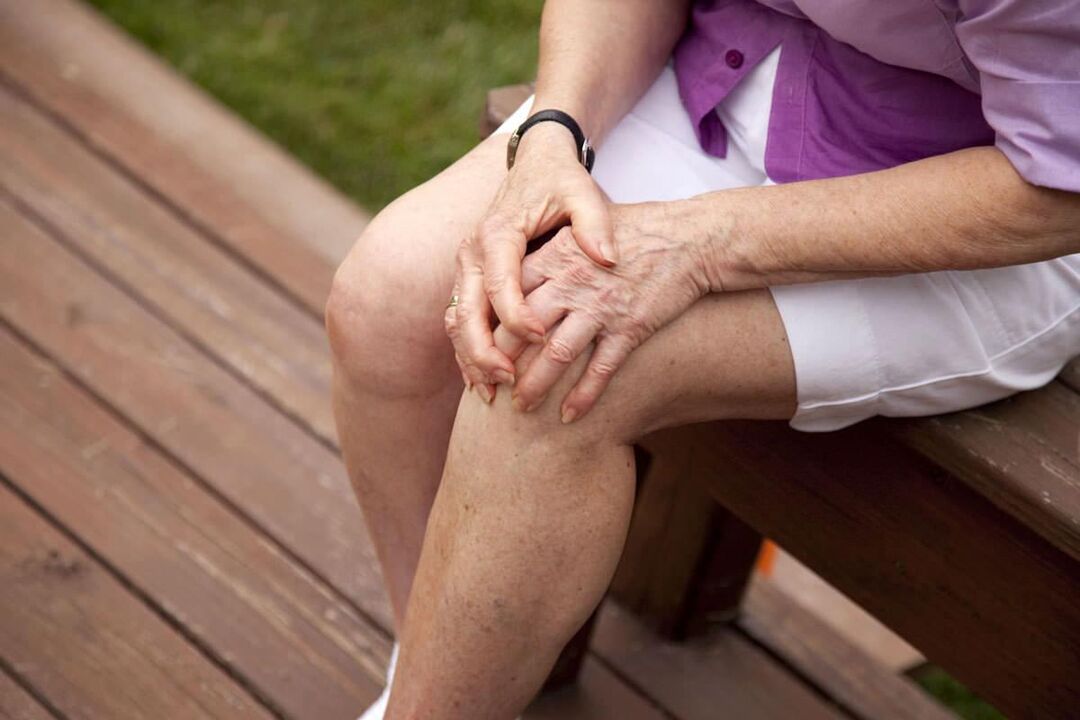Arthrosis of the knee joint is understood as a decrease in cartilage performance due to its curvature and destruction. Other terms are used to refer to this disease -gonarthrosisanddeformity of osteoarthritis. Currently, several methods of treating the disease are used: specific options are selected taking into account the individual characteristics of the patient.
Specificity of the disease
Osteoarthritis of the knee usually develops progressively. As a rule, it occurs in women and the elderly who are overweight or have vascular defects. The disease can occur on one or both knees at once.
The main stages of the development of arthrosis in the knee:
- The beginning. There is a decrease in the depreciation parameters of the joint due to friction of the cartilage joint and an increase in its roughness. Occasionally crack formation is observed.
- Second. At this stage, the bones begin to cover with tumors (osteophytes). On the inner surface of the articular bag, constant curvature, stiffness is observed in limb work. As a result, the knee joint gradually reduces its function. Due to the decrease in the thickness of the intercartilaginous layer, a reduction in the distance between the tibia and femur was observed.
- Third. If nothing is done, the pain in the knee area becomes permanent as a result of irreversible damage to the cartilage tissue. Patients at this stage are no longer able to move normally.
The first symptom of arthrosis of the knee joint is a sufficient reason to consult a specialist. Otherwise, there is a real danger of becoming disabled.

Why arthrosis appears
The main causes of the development of arthrosis of the knee joint:
- hereditary tendencies;
- temporary immobility of the knee joint due to injury;
- surgical removal of the meniscus;
- high physical activity, persistent hypothermia;
- obesity, overweight problems;
- ligament disorders (their weakness);
- other joint diseases (arthritis, swelling, various inflammations);
- normal metabolic failure, lack of calcium in the body;
- flat feet (failure of the center of gravity increases pressure on the joints);
- stress, general fatigue, lack of sleep.
symptoms
Possible signs of the presence of knee osteoarthritis:
- Pain in the knee joint. The pain appears suddenly, against a background of physical exertion. In the first stage, we talk about the almost invisible lumbago, then the disease becomes more serious.
- Visual violation of the shape of the knee. It happens in the final stages.
- Fluid accumulation, Baker's cyst. This is a significant sealing in the posterior area of the knee joint.
- Crispy appearance of cartilage, with a background of sharp pain. This indicates the second or third stage of gonarthrosis.
- Inflammation of the inner area of the articular bag. It is indicated by edema and increased cartilage.
- Knee stiffness due to severe pain, resulting in complete paralysis. This occurs in the advanced stages of the disease.

Treatment
Effective treatment of knee joint arthrosis is only possible using an integrated approach. Modern medicine has not yet offered a specific drug that can eliminate this disorder. The success of the treatment procedure depends on the timeliness of problem detection, which allows you to begin the fight against gonarthrosis at an early stage.
Starting treatment, specialists pursue several goals:
- reduce pain symptoms as much as possible;
- to resume the normal flow of nutrients to the joints;
- increase the intensity of blood circulation in the knee area;
- restore supportive muscle function in problem areas;
- make the knee as mobile as possible;
- widens the space between the connected bones.
The exact treatment algorithm is determined individually. Distinguish between conservative and surgical techniques.
conservative methods
This approach is used in the early stages of disease onset, and is the use of a variety of medications and therapeutic exercises.
Painkillers, anti-inflammatory drugs
To eliminate or reduce pain in the knee joint, doctors usually prescribe the use of non-steroidal anti-inflammatory drugs. In pharmacies, they are represented by tablets, ointments and injections. Warming gels and anesthetics, ointments and patches show good effectiveness in relieving pain.
Positive results in this case are usually achieved in 3-4 days. It should be understood that these drugs do not eliminate the disease, but only reduce the pain. It is recommended to take painkillers only on the advice of a specialist and only when correcting unbearable pain. The fact is that NSAIDs trigger the appearance of various side effects (especially the gastrointestinal tract suffers).
Hormone drugs
In some cases, to relieve pain in knee osteoarthritis, doctors may prescribe hormone injections. This approach is used when the efficacy of NSAIDs is weak against a background of progressive disease.
Hormones are prescribed for a short period (1-10 days) during exacerbations of arthrosis and accumulation of fluid in the knee joint.
Chondroprotectors
To restore and nourish the cartilaginous layer at the beginning of disease progression, called. chondroprotectors (glucosamine, chondroitin sulfate). Glucosamine initiates the process of cartilage regeneration, corrects metabolism, inhibits destructive processes. Chondroitin sulfate disarms harmful enzymes, increasing the amount of collagen (this protein nourishes cartilage with moisture). According to leading physicians, these drugs currently show the greatest positive effects in the treatment of gonarthrosis.
In particularly critical cases, when cartilage tissue has undergone serious anomalies, chondroprotectors are ineffective. When prescribing glucosamine and chondroine sulfate, the doctor prescribes a specific daily dose. Only a systematic approach to taking these medications provides an opportunity for positive results. On sale they are represented by tablets, capsules, injections, gels.
Vasodilator
To remove the spasm of the vascular system, optimize blood flow and metabolism in the knee area, doctors prescribe funds for vasodilation. As a rule, they are prescribed in combination with chondroprotectors. If, against the background of arthrosis, fluid in the knee is not collected, it is permissible to rub the joint with a warming ointment and attend a therapeutic massage session.
Hyaluronic acid
In its chemical composition, this material is very close to intra-articular fluid. After being inserted into the joint, the acid produces a film that protects the cartilage from joint friction. It is permissible to use the drug after the cessation of deterioration.
Therapeutic exercise
For osteoarthritis of the knee, use exercise therapy, but only under close supervision by a treating physician or an experienced trainer. Self-medication is strictly prohibited, given the great risk of any careless movements and loads. The use of proper physiotherapy exercises helps keep joints in working condition, relieve muscle cramps, and reduce unpleasant symptoms. It is strictly forbidden to perform physiotherapy exercises during severity or in inappropriate conditions.
Physiotherapy
Using physiotherapy techniques properly, you can significantly reduce pain in the knee area, relieve inflammation, and increase the flow of nutrients to joint tissue. Before prescribing physiotherapy, the orthopedic specialist conducts a detailed diagnosis of the problem area, prescribes general and special tests, sends an ultrasound or X-ray. This approach allows you to create a true picture of the problem and choose the best method.
The following types of physiotherapy have a good analgesic effect:
- UV irradiation. Due to exposure to ultraviolet radiation, there is a decrease in the sensitivity of the nerve endings and a decrease in pain. As a rule, it is prescribed in the final stages of the disease. The standard duration of treatment is 7-8 sessions.
- Local magnetotherapy. Improves the overall health of patients by reducing pain, inflammation, muscle spasms. Magnetotherapy is usually prescribed at the first onset of symptoms of knee arthrosis. The number of standard procedures is 20-25 sessions of 30 minutes each.
- Infrared laser therapy, UHF, SMW devices, ultrasound, therapeutic baths, etc.
If the disease has entered the stage of dystrophic changes and deformities, the doctor recommends treatment of a sanitary center. A list of specific procedures was compiled after a thorough review of the patient’s history.

Surgery
This approach, with proper implementation, can partially or completely connect the work of the knee joint. The formation of the surgical intervention algorithm takes into account the degree of destruction of cartilage tissue, the degree of inflammation, the amount of fluid collected, etc. As a rule, surgical intervention is practiced in the final stages of gonarthrosis. This approach implies fragment or complete replacement of the affected joint with endoprosthesis.
The main approaches to surgical treatment:
- Arthrodesis of the joints. During surgery, the surgeon corrects the foot in the most comfortable position for the patient, followed by immobilization of the knee joint. Damaged cartilage is completely removed. Such a radical approach is only relevant in extreme cases.
- Arthroscopic Debridement. It is used in the second stage of development of knee arthrosis. Surgical removal of damaged cartilage tissue is performed, which allows you to save a person from pain for several years (usually for 2-3 years).
- Endoprosthetics. In this case, the knee joint or a separate part thereof is replaced with a plastic, ceramic or metal implant that completely repeats the anatomical configuration of the natural joint. Endoprosthetics today are considered the most effective way to fully restore a lifestyle to an arthrosis knee for the next 15-20 years.
Efficient planning and implementation of surgical treatment makes it possible to improve the well -being of the patient and restore his mobility (partially or completely). At the same time, it should be understood that after surgery, a long recovery period will be required, attending physiotherapy training, mechanotherapy, dieting, etc.
Recovery
On average, the recovery period after surgical treatment takes 90 days:
The main tasks of recovery:
- resumption of the patient's ability to move normally;
- optimization of muscle and joint function;
- creation of protective blocks for prostheses.
Drainage is removed 2-3 days after surgery, after which you can try to walk carefully. To relieve pain, doctors prescribe medication with a cooling effect. Minor pain symptoms sometimes persist for a year after surgery: this is due to the fact that the prosthesis takes time to heal. Elderly patients recover longer: to alleviate their condition, they are prescribed NSAIDs. In some cases, the attending physician prescribes hormonal agents that have a clear effect.
A week later, the patient entered a rehabilitation center under the care of an experienced physiotherapist. When developing a course of exercise therapy, the individual characteristics of the body are taken into account. Classes are held periodically (daily), with a gradual increase in load: this protects against injury and tissue rupture.
Period after discharge
At the end of the stay at the rehabilitation center, the patient was discharged, giving him detailed recommendations on his future lifestyle. Dancing and light gymnastics are allowed after 6 months from the date of surgery. For serious loads (speed running, jumping, sports games, heavy squats), it must be completely excluded. Otherwise, the prosthesis will quickly fail.
Do not lift heavy objects that weigh more than 25 kg. In the dwelling, it is necessary to install a support handrail: it is placed on the stairs, in the bathroom, and the bathroom. All furniture must be fully functional (especially chairs). These and other measures will maximize the life of the prosthesis. You should also be prepared for postoperative arthrosis of the knee joint, which can last up to 3 years.
Prevention of disease onset
The best way to deal with any disease is to prevent it from happening.
An effective wayprevention of knee osteoarthritis:
- Proper nutrition, maintaining a normal weight. It is better to eliminate fatty and fried foods, alcohol, coffee, etc. from your diet. An experienced nutritionist can give detailed advice on this.
- Be careful while exercising. It is desirable to reduce the load on the joints as much as possible.
- Beware of any disease (especially infectious ones), treat it properly, and avoid the chronic stage.
- Watch your posture, do not be negligent about diseases of the bones and spine.
- Include gentle physical activity in your daily routine (cycling, swimming, walking, doing strengthening exercises for the joints).
- Avoid any self -treatment options for knee arthritis. At the first symptoms of the disease, you should immediately contact the clinic.
- Live a quiet lifestyle without stress and lack of sleep.
- Take steps to strengthen immunity (hardening, taking vitamins).
- Dress warmly in the winter.
By applying the principles of a healthy lifestyle in your life and getting timely medical help, you can minimize the risk of getting knee joint arthrosis. When choosing a clinic, priority should be given to proven treatment centers equipped with modern equipment.



















